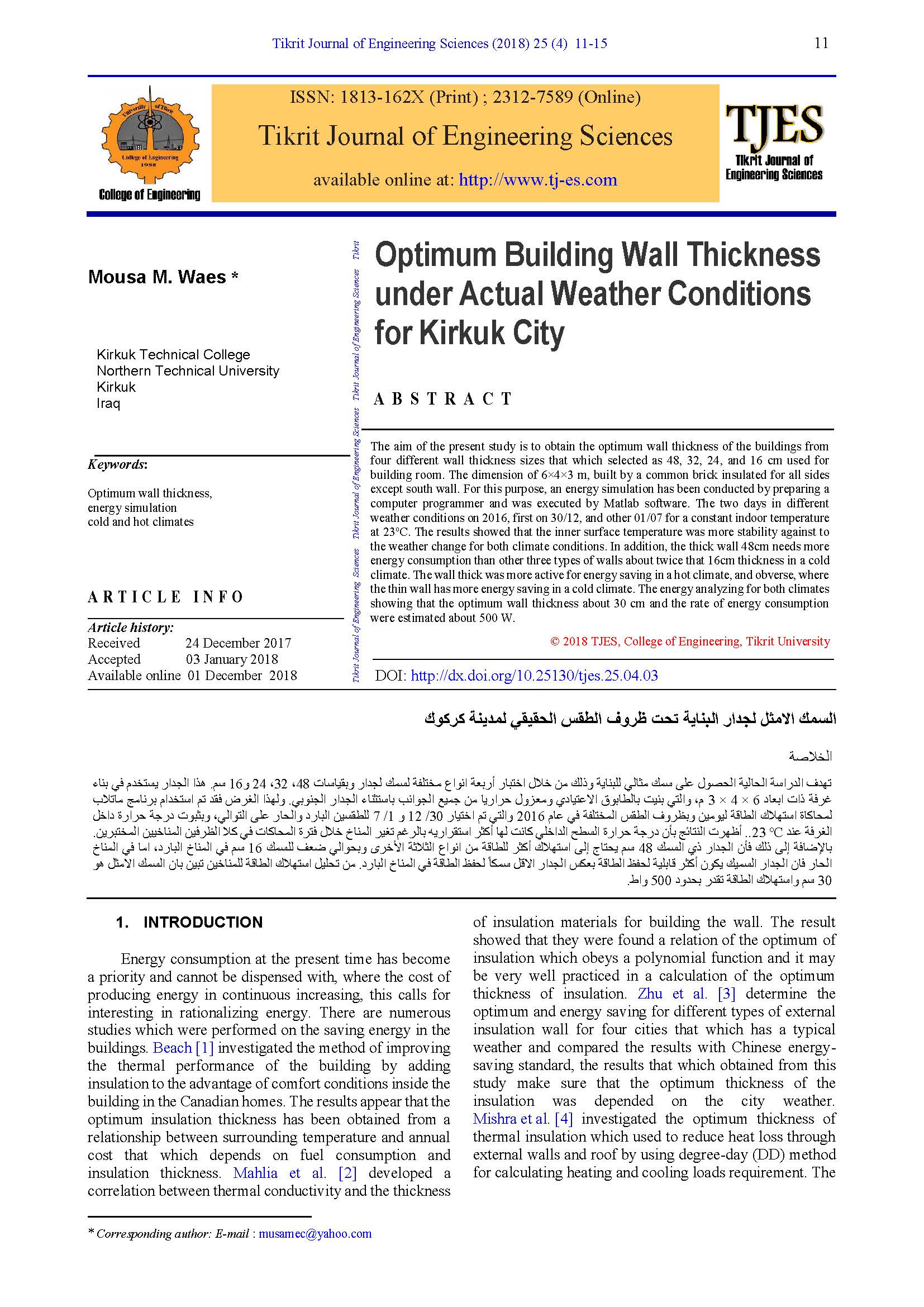Optimum Building Wall Thickness under Actual Weather Conditions for Kirkuk City
Main Article Content
Abstract
The aim of the present study is to obtain the optimum wall thickness of the buildings from four different wall thickness sizes that which selected as 48, 32, 24, and 16 cm used for building room. The dimension of 6×4×3 m, built by a common brick insulated for all sides except south wall. For this purpose, an energy simulation has been conducted by preparing a computer programmer and was executed by Matlab software. The two days in different weather conditions on 2016, first on 30/12, and other 01/07 for a constant indoor temperature at 23oC. The results showed that the inner surface temperature was more stability against to the weather change for both climate conditions. In addition, the thick wall 48cm needs more energy consumption than other three types of walls about twice that 16cm thickness in a cold climate. The wall thick was more active for energy saving in a hot climate, and obverse, where the thin wall has more energy saving in a cold climate. The energy analyzing for both climates showing that the optimum wall thickness about 30 cm and the rate of energy consumption were estimated about 500 W.
Metrics
Article Details

This work is licensed under a Creative Commons Attribution 4.0 International License.
THIS IS AN OPEN ACCESS ARTICLE UNDER THE CC BY LICENSE http://creativecommons.org/licenses/by/4.0/
Plaudit
References
Beach RK. Determining the optimum thickness of insulation for heated buildings. Technical Paper, National Research Council Canada. Division of Building Research 1965; 5: 1-10.
Mahlia TMI, Taufiq BN, Masjuki HH. Correlation between thermal conductivity and the thickness of selected insulation materials for building wall. Energy and Building 2007; 39: 182-187. DOI: https://doi.org/10.1016/j.enbuild.2006.06.002
Zhu P, Huckemann V, Fisch MN. The optimum thickness and energy saving potential of external wall insulation in different climate zones of China. Procedia Engineering 2011; 21: 608-616. DOI: https://doi.org/10.1016/j.proeng.2011.11.2056
Mirsha S, Usmani JA, Varshney S. Optimum insulation thickness of external walls and roof for different degree-day region. International Journal of Engineering Research and Technology 2012; 1(7): 1-8.
Fertelli A. Determination of optimum insulation thickness for different building walls in Turkey. Transitions of Famina 2013; XXXVII-2: 103-113.
Basrawi F, Ibrahim H, Lee GC. Optimum thickness of wall insulation and their thermal performance for building in Malaysia climate. International Journal of Automotive and Mechanical Engineering 2013; 8: 1207-1217. DOI: https://doi.org/10.15282/ijame.8.2013.11.0099
Nyers J, Tomic S, Nyers A. Economic optimum of thermal insulation layer for external wall of brick. Acta Polytechnica Hungarica 2014; 11(11): 209-222. DOI: https://doi.org/10.12700/APH.11.07.2014.07.13
Kaynakali O, Canbolat AS, Saka K, Yamankaradeniz R. Optimization of insulation thickness for external walls considering deferent climatic conditions. Proceedings of The IRES International Conference 2017 Feb 1-2; Dubai, UAE: p.1-5.
Holman JP. Heat transfer, 10th ed., New York: McGraw-Hill, Higher Education; 2010.
Abbas EF. Comparative study of thermal performance for various heating systems which are acting passively. Ms.C. Thesis, University of Technology; Baghdad, Iraq: 1999.





